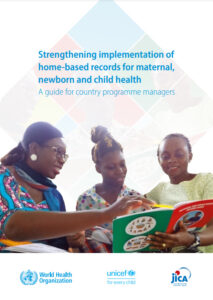
Overview
The World Health Organization recommends the use of home-based records as a complement to facility-based records for the care of pregnant women, mothers, newborns and children in order to improve care seeking behaviours, men’s involvement and support in the household, maternal and child home care practices, infant and child feeding, and communication between health workers and women, parents and caregivers.
Despite the wide use of home-based records, implementation challenges persist, such as stock-outs, incorrect use of home-based records by health workers or low retention by women, parents and caregivers that impede the home-based record’s potential.
The guide was developed in response to the implementation issues and seeks to provide decision-making tools and activities, links to existing resources and examples from countries that can be used to strengthen processes for planning, design, implementation and monitoring of home-based records.
Forward
Home-based records have a long history, initially used to record proof of smallpox vaccinations in the mid-1800s and subsequently used to document health services and provide health education to mothers in Japan in the mid- 1900s. Today, countries have many different types of home-based records, ranging from records covering single health areas such as antenatal notes or vaccination-only cards to more expanded content such as child vaccination and nutrition cards, or integrated maternal and child health handbooks. These documents are used to record an individual’s history of health services received and can also provide basic health and development promotion messages.
In guidance put forward by the World Health Organization (WHO) in 2018, home-based records are recommended to improve care-seeking behaviours, men’s involvement and support in the household, maternal and child home care practices, infant and child feeding and communication between health workers and women and caregivers. However, the research and reports available on home-based records use for maternal, newborn and child health reveal that implementation challenges persist in many countries. Data collected through a WHO and United Nations Children’s Fund (UNICEF) standard questionnaire sent annually to all Member States indicates that in 2020, 25 out of 162 countries had stock-outs of home-based records and 15 countries had stockouts over at least three years. This implies that cohorts of women and children do not receive these records, and also reveals the need to strengthen planning, implementation and monitoring of home-based records.
This implementation guide aims to provide activities and decision-making tools to strengthen processes for planning, designing, implementing, and monitoring of home-based records with the aim to maximize the benefits for all users: women, parents, caregivers, health workers and programme managers. The guide will support, and is complementary to, broader ongoing efforts to strengthen primary health care and health programming for women and children. Moving forward, digital technologies can be applied to increase access and use of home-based records and strengthen links to health management information systems.
WHO, UNICEF and the Japan International Cooperation Agency (JICA) are committed to collaborate on strengthening the use and implementation of home-based records for maternal, newborn and child health, in attainment of the 2030 Agenda for Sustainable Development, particularly in those settings where services and systems are fragile and fragmented.
We encourage country programme managers and implementing partners to adopt this guide and collaborate with national stakeholders to strengthen their own national processes and ensure their investment in home-based records achieves its objectives for improved health.
Downloads
Web Annex A. Blank templates (for printing) for activities included in this guide
Related information
More information about strengthening home-based record implementation